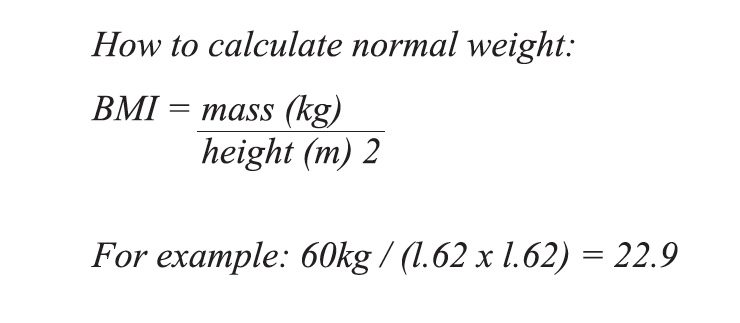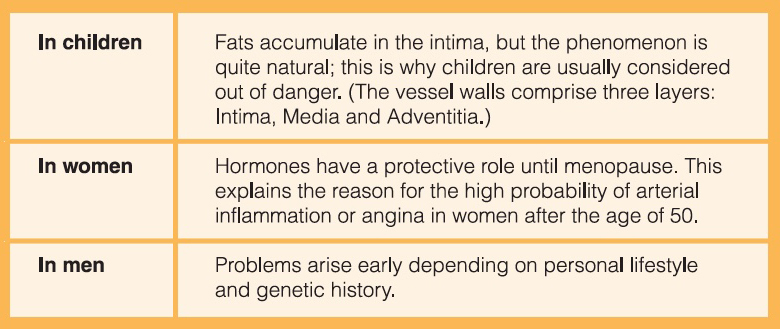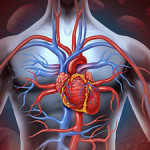Cholesterol control simple actions

A high level of low density lipoproteins (LDL) could lead to cardiovascular disease, especially in the absence of balanced nutrition and general neglect of health. Fatty plaques accumulate around vessels and arteries, and aggravate the condition to the point of no return. However, disaster can be averted by following simple precautions for a healthy lifestyle.

Calculating the body mass index (BMI) has become a well known tool in measuring the impact of dietary changes and determining the risk of heart disease. However, the waist circumference is a more effective indicator of cardiovascular risks. Knowing the BMI, measuring the waist, and regularly checking the weight will help in warning of a high cholesterol level.
Normal weight is between 19 and 25. It is natural for the BMI to increase with age even though the person is following the same dietary pattern. When the BMI is less than 18, it is in the underweight category and the risk of anorexia is increased. When the BMI is more than 25, it is in the overweight category and may lead to obesity. The waist circumference should not exceed 80cm for women and 102cm for men.

We often notice high cholesterol levels in those over 50 years old, but this may affect younger persons as well. Some people suffer from obesity or hypercholesterolemia due to heredity. It is necessary to inform the doctor about the family health history, to help determine what precautionary measures to take. Often, patients are advised to decrease consumption of products with a high glycaemic index. Vegetables, fruit and whole grains have a low glycaemic index, compared to bread, rice, fries and sweets.
Keeping a check on cholesterol
Periodic blood test
There is no need to apply this evaluation during adolescence, but it is necessary after the age of 40. Based on the test results, the cholesterol level should be monitored every two to three years at least. Patients often refuse to consult their doctor regarding a high cholesterol level, with their main excuse being ‘no time’. However, from the age of 50, it is better for the patient to monitor the basic indicators related to high cholesterol level, as prevention is better than treatment.
Limit intake of saturated fats
The first step is to be able to differentiate between saturated and unsaturated fats – we tend to name these as ‘bad’ fats or ‘good’ fats. The descriptions are not accurate because extra fats are bad for the body, whether saturated or not. Nevertheless, this doesn’t stop some media outlets and dietitians from encouraging the consumption of ‘good’ fats, meaning unsaturated fats found in oily nuts and fatty fish specifically. Unsaturated fats remain in a liquid state when cooked at a low temperature. Monounsaturated fats lower the LDL (bad) cholesterol level in blood, while polyunsaturated fats work on the total cholesterol level.
Consume omega-3
Omega fatty acids help in the functioning of the vascular and cardiac systems, as well as protect them. As the body cannot make omega fatty acids, these must come from food sources.The fatty acids include not only omega-3, but also omega-6 and omega-9 found in some oils such as sunflower oil and soybean oil. One problem today is that the nutritional pattern lacks essential fatty acids. The consumption of sardines, walnuts and almonds has decreased, while fresh fish has become quite expensive.
Eat fruit and vegetables
Those who have a high cholesterol level are advised to maintain a balanced diet. This should include fruit and vegetables as these are rich in vitamins, minerals and antioxidants, and therefore have a role in preventing the formation of fatty plaques on the walls of vessels. Studies have showed that the lack of certain substances enhances LDL oxidation – for example, a deficit in Vitamins C and E, polyphenols found in fruits and vegetables, dietary plant fibres and calcium.
Get regular exercise
To boost the effect of the new nutritional pattern, add physical activity. This will help decrease the LDL level and increase the level of high density lipoprotein (HDL) or ‘good’ cholesterol. Create an exercise programme that takes into consideration your age and general health status, and which keeps you motivated to work out. If you have not been active, begin slowly and increase the intensity gradually.
Drink sufficient water
Hydrating the body will revitalise it and help in maintaining a perfect weight. Doctors recommend drinking 1.5-2 litres of water per day. You can substitute part of the intake with healthy liquids like green tea or fresh juices.
Control blood pressure
Hypertension increases the risk of myocardial infarction. Visiting the doctor is a way to have peace of mind. Beverages that act as stimulants (coffee, tea or energy drinks) can increase blood pressure, as does salt. So, reduce intake.
Stop smoking
Smoking is bad for health in general, and also increases the LDL cholesterol level. Smokers should stop this habit early. Often, cessation will make the body gain weight. A suitable diet and routine exercise will help.
Boost vitamins after menopause
The dietary pattern usually provides all the nutrients needed by the body. However, the body may not get enough of some essential nutrients in some situations. In women, this becomes obvious after menopause. Without the protective effect of hormones, it is common for women to experience a lack of iron and Vitamin D, for instance. This is not dangerous but we recommend a general check-up after the first blood analysis following menopause.
Maintain the diet
Some will find it easy to commit to a particular diet or weight maintenance programme, while others find it an ordeal. Ask for help where necessary.
Note that emotional trauma can be translated in the body by an increase or a decrease in weight. Those with hypercholesterolemia will have to keep to a steady and balanced nutritional pattern for life.
It is normal to experience overeating at some point. Carefully control intake, especially during festive occasions when food is abundant. Losing weight becomes very hard especially after a certain age. Eat what you like from time to time but try to lose the extra weight quickly, either through exercise or by avoiding certain kinds of food or decreasing the amount consumed.
Disclaimer: This article is extracted from an article of the same title that appeared in Global Oils & Fats Business Magazine (Vol 12, Issue 2)










Leave a Reply